Roofing Companies Broadview
Best Roofing Company in Broadview
Get 3 FREE Roofing Service quotes for your project today! Compare profiles, reviews, accreditations, portfolio, etc... and choose the best service.
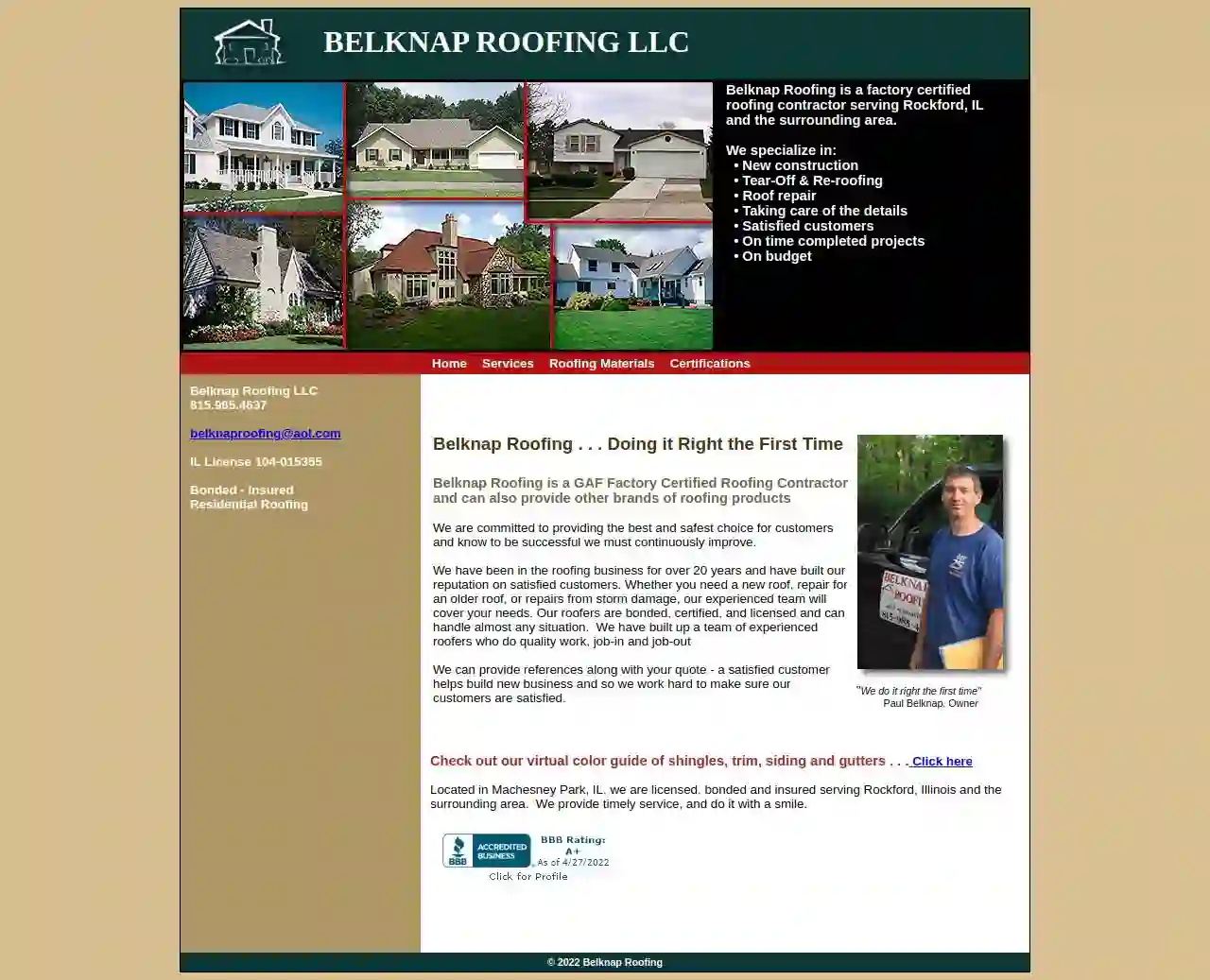
Belknap Roofing, L.L.C.
54 reviews10100 N. Second Street, Machesney Park, 61115, USBelknap Roofing is a factory certified roofing contractor serving Rockford, IL and the surrounding area. We specialize in: • New construction • Tear-Off & Re-roofing • Roof repair • Taking care of the details • Satisfied customers • On time completed projects • On budget Belknap Roofing is a GAF Factory Certified Roofing Contractor and can also provide other brands of roofing products. We are committed to providing the best and safest choice for customers and know to be successful we must continuously improve. We have been in the roofing business for over 20 years and have built our reputation on satisfied customers. Whether you need a new roof, repair for an older roof, or repairs from storm damage, our experienced team will cover your needs. Our roofers are bonded, certified, and licensed and can handle almost any situation. We have built up a team of experienced roofers who do quality work, job-in and job-out. We can provide references along with your quote - a satisfied customer helps build new business and so we work hard to make sure our customers are satisfied. "We do it right the first time" Paul Belknap, Owner Check out our virtual color guide of shingles, trim, siding and gutters . . . Click here Located in Machesney Park, IL, we are licensed, bonded and insured serving Rockford, Illinois and the surrounding area. We provide timely service, and do it with a smile.
- Services
- Why Us?
- Accreditations
- Our Team
- Gallery
Get Quote
A Grade Construction | Commercial Roofing & Masonry | Chicago
543 reviewsA Grade Construction & Roofing Masonry, 123 Main St, Chicago, 60657, USA Grade Construction & Roofing Masonry is a premier commercial and residential construction services company providing General Contracting and Construction Management Services in all of Chicagoland and its suburbs. With over 20 years of experience, we understand the importance of a project when it comes to details. Our team of experienced professionals is ready to assist you with all your roofing needs, from installations to repairs, to regular maintenance and check-ups. We pride ourselves on providing top-quality services and will cater to all your needs, from residential to commercial roofing, masonry, and rappelling services. Contact us to schedule an appointment and let us take care of all your needs.
- Services
- Why Us?
- Gallery
Get Quote
Frontline Adjusters
4.656 reviews1606, 1 Willow View Rd Suite 1G, Urbana, 61802, USFrontline Adjusters is a team of public insurance adjusters dedicated to helping Illinois homeowners navigate the complexities of insurance restoration after storm damage. We prioritize clear communication and ethical practices, ensuring you get a new roof without unnecessary stress. Our commitment to quality craftsmanship and a 2-year workmanship warranty gives you peace of mind knowing your investment is protected. We proudly serve Chicagoland, Peoria, Urbana, Springfield, and surrounding areas. Our team of experts understands the insurance restoration process inside and out. We'll guide you through every step, from filing the claim to working with the adjuster, ensuring you receive fair and comprehensive compensation. At Frontline Adjusters, we believe in transparency and building lasting relationships with our clients. We're dedicated to providing exceptional service and advocating for your best interests throughout the entire process.
- Services
- Why Us?
- Accreditations
- Our Team
- Testimonials
- Gallery
Get Quote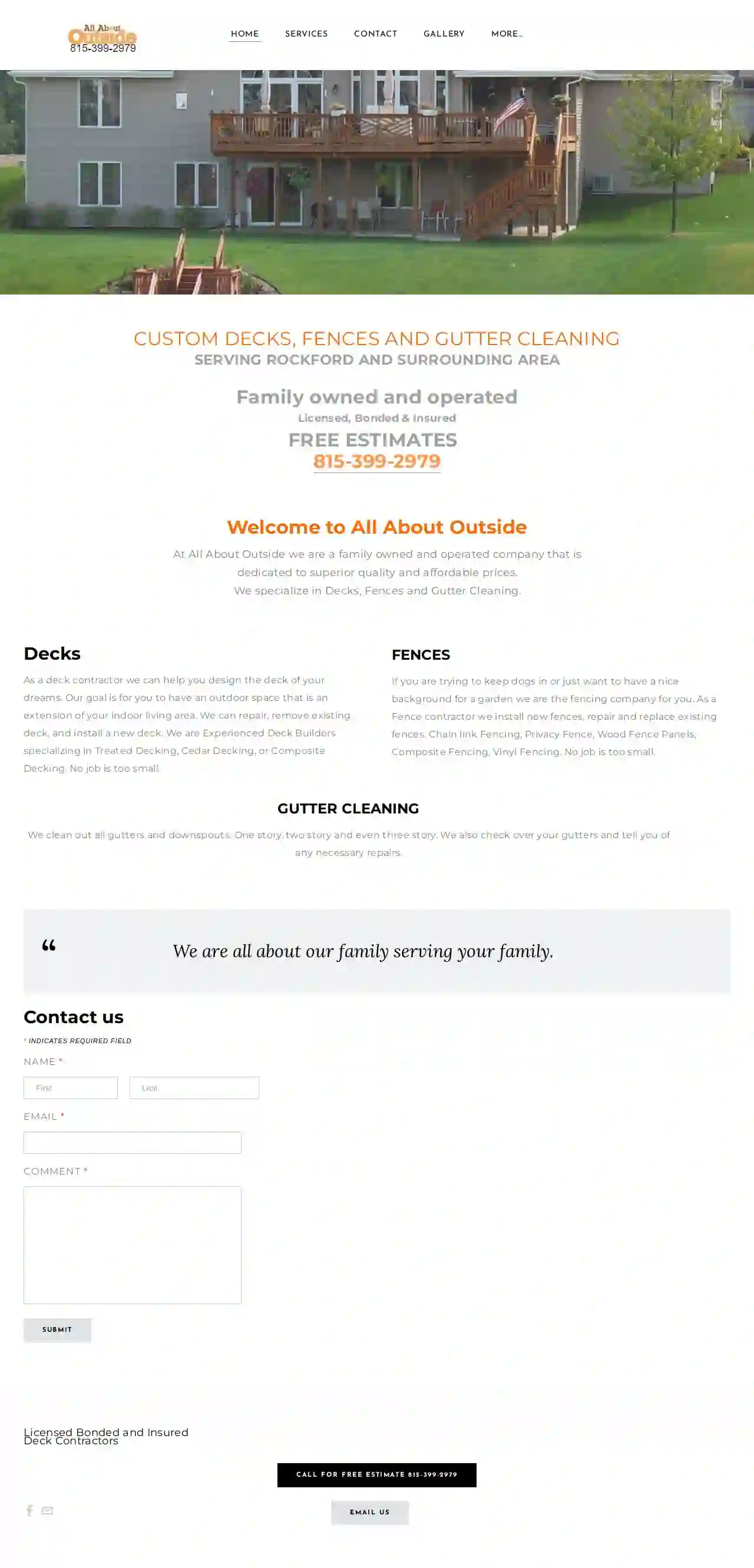
All About Outside
51 reviewsRockford, 61107, USAt All About Outside, we're a family-owned and operated company dedicated to providing superior quality and affordable prices. We specialize in decks, fences, and gutter cleaning, serving Rockford and the surrounding area. Our goal is to help you create an outdoor space that's an extension of your indoor living area. Whether you need a repair, removal, or a brand new deck, we've got you covered. We're experienced deck builders specializing in treated decking, cedar decking, or composite decking. No job is too small. If you're looking to keep your dogs in or simply want a beautiful backdrop for your garden, we're the fencing company for you. We install new fences, repair and replace existing ones, and offer a variety of options, including chain link, wood picket and privacy, dog enclosures, composite, and vinyl fencing. Again, no job is too small. We also provide comprehensive gutter cleaning services for all types of homes, from one-story to three-story. We'll clean out your gutters and downspouts, check for any necessary repairs, and ensure your drainage system is in top shape. We're all about serving your family with the same care and dedication we give our own. Contact us today for a free estimate!
- Services
- Why Us?
- Gallery
Get Quote
RENAISSANCE Historic Exteriors
4.933 reviewsRockford, IL, P.O. Box 5024, 61125, USBRINGING NEW LIFE TO HISTORICAL BUILDINGS Renaissance Historic Exteriors is Hiring! Our Promise & Mission Our promise is to use our comprehensive approach to your historical renovation in order to find you a permanent solution.Our mission is to elevate the lives of our people, using our expertise and craftsmanship to preserve history. JOIN OUR TEAM Are you looking for an interesting, fulfilling job where you can work on once-in-a-lifetime projects for a company you're proud to work for? We're hiring! OUR SAFETY PROGRAM The Renaissance culture revolves around safety. We consistently achieve an industry-leading Experience Modification Rating (EMR), and this proven history of safe work allows for lower insurance rates--savings that we are able to pass along to our customers. MAKE YOUR year MATTER WITH THIS UNIQUE, HANDS-ON OPPORTUNITY Renaissance Historic Exteriors is seeking hard-working individuals to join our seasonal crew for restoration work on a historical building located in Frankfort, KY. Project is set to begin in late 2022. A nationally recognized leader in the field of historical building restoration since 1992, we construct custom restoration solutions for historical homes, churches, universities, courthouses, and state capitol buildings, including many buildings on the National Register of Historic Places. Skilled in both residential and commercial restoration, our full range of services include historical tile and slate roofing, architectural sheet metal, historical carpentry, historical masonry, gutters and downspouts, plus access to the largest inventory of HISTORICAL ROOFING MATERIALS in the U.S. — everything needed to restore your historical building, under one roof. Customers appreciate our unparalleled commitment to client success, our proven Monarch Elite Process, and our industry-leading safety program. Historical building specialists want to work with us because we take on challenges that no one else in the business can. OUR SERVICES TOUCH HISTORIC ROOFING HISTORIC ROOFING TOUCH HISTORIC CARPENTRY HISTORIC CARPENTRY TOUCH HISTORIC MASONRY HISTORIC MASONRY TOUCH ARCHITECTURAL SHEET METAL ARCHITECTURAL SHEET METAL TOUCH COMPLETE RESTORATIONS COMPLETE RESTORATIONS TOUCH GUTTERS & DOWNSPOUTS GUTTERS & DOWNSPOUTS TOUCH HAIL & STORM DAMAGE RESTORATION HAIL & STORM DAMAGE RESTORATION TOUCH HISTORIC BUILDING CONSULTATIONS HISTORIC BUILDING CONSULTATIONS TOUCH BUY AND SELL HISTORIC ROOF MATERIALS BUY AND SELL HISTORIC ROOF MATERIALS OUR PROCESS Our proven Monarch Elite Process is a seven-step transformation that begins the moment you reach out to us and ends with the emergence of your beautifully restored building.We begin with our Magellan Building Assessment (MBA), a comprehensive inspection of both the interior and exterior of your property. Our Historical Building Specialist’s expert investigation gives you visibility into your building’s assets and potential liabilities, and we work with you to determine next steps. Learn About The Monarch Elite Process GET AN MBA FROM RENAISSANCE
- Services
- Why Us?
- Testimonials
- Gallery
Get Quote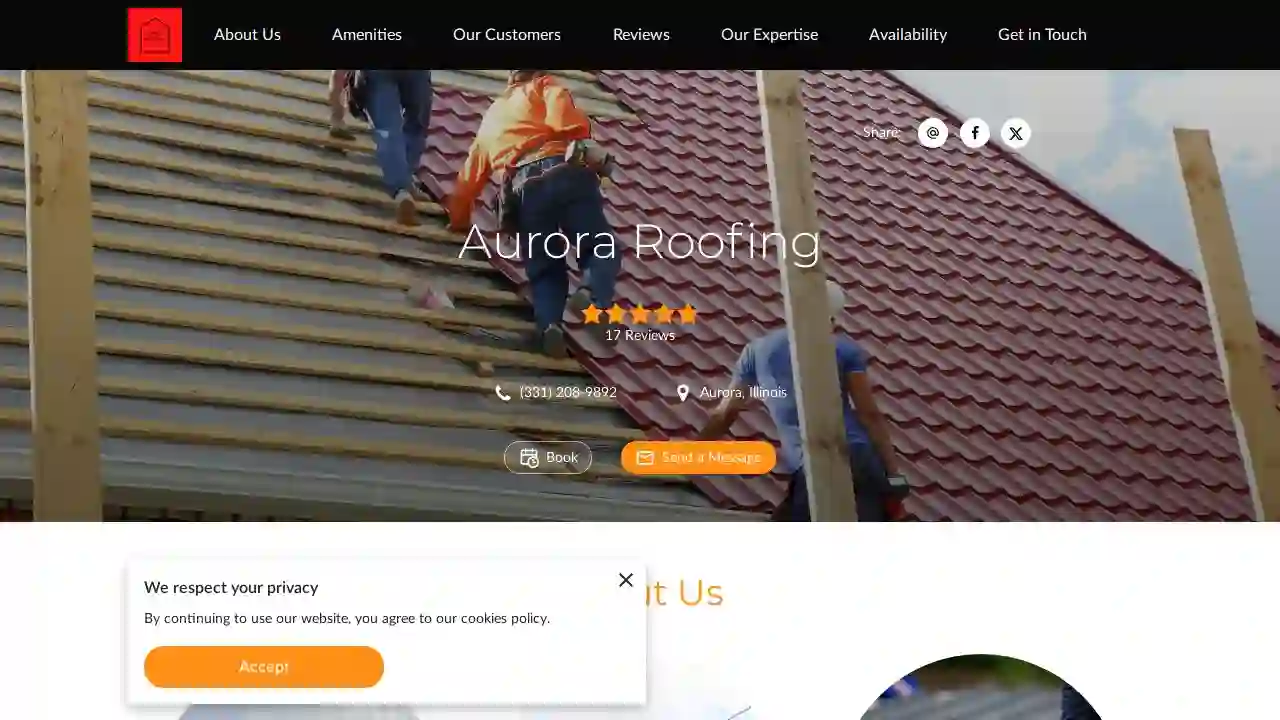
Aurora Roofing
4.912 reviewsAurora, USAt Aurora Roofing, you'll find a family run and owned business in Aurora with years of experience. Rest assured, we are the roofers – all the work is done in-house. We pride ourselves on our commitment to quality and customer satisfaction. Discovering a leak in your roof can be a real worry, but our team of fully trained and experienced roofers are able to quickly and easily fix all manner of roofing problems. We approach all our projects with the same commitment and professionalism and we’re proud of our hard-earned reputation for skilled workmanship and reliability.
- Services
- Why Us?
- Testimonials
- Gallery
Get Quote
American Roofing Supply
4.813 reviewsRockford, USSince 1983, American Roofing Supply has taken pride in serving contractors and communities across 10 states with the finest in both residential and commercial roofing materials. American Roofing Supply offers roofing materials and accessories from a wide array of manufacturers ranging from asphalt composition shingles, commercial roofing products, metal roofing products to wood shakes and tile/slate. With 35 convenient locations spread across the United States, we are able to meet your every roofing need. Here at American Roofing, we believe our exceptional service is what sets us apart and makes us stand out. Our friendly and knowledgeable sales staff is here to help with your every roofing need.
- Services
- Why Us?
- Testimonials
- Gallery
Get Quote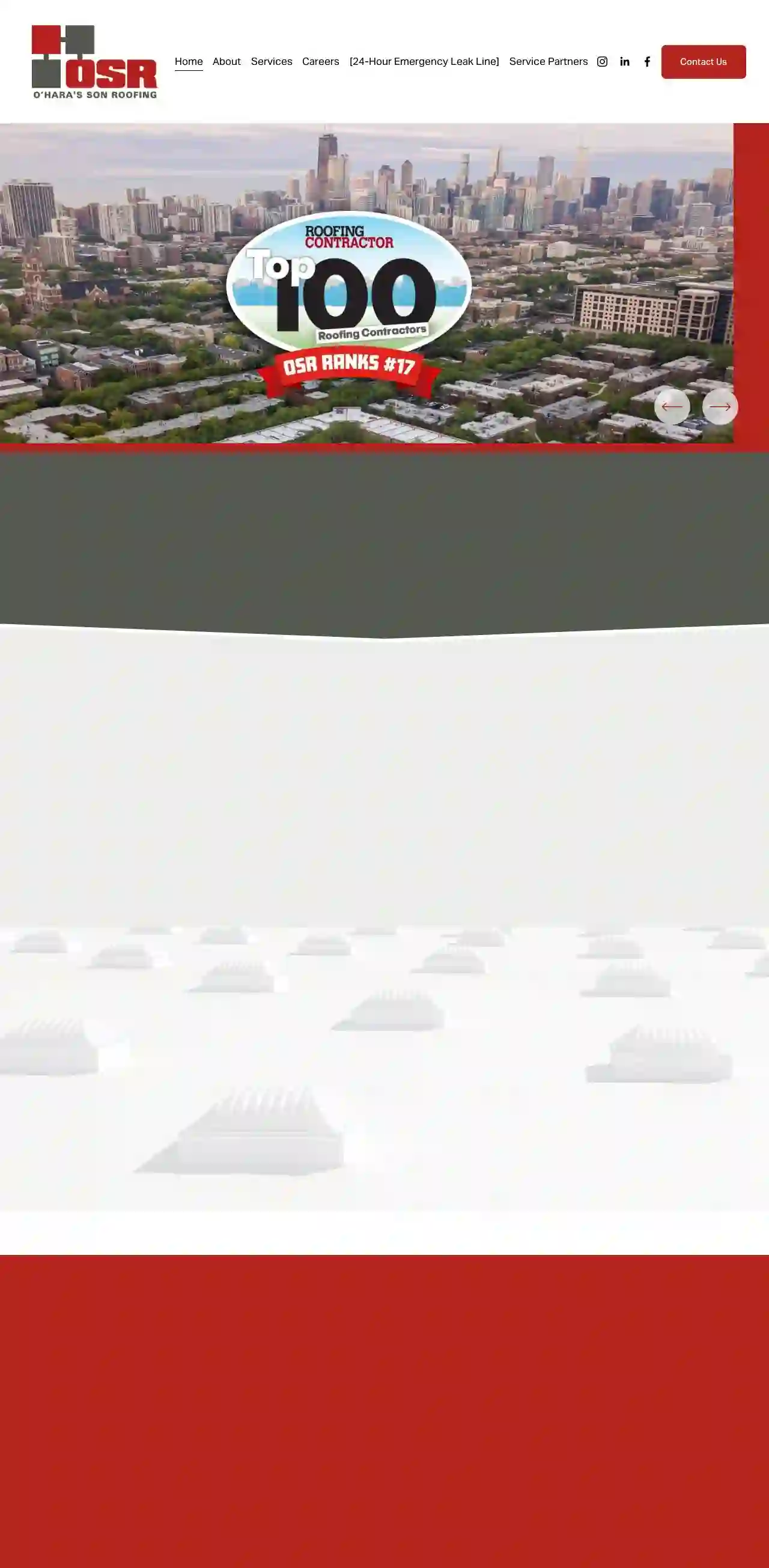
O'Hara's Son Roofing Company
446 reviews6437 N Avondale Ave., Chicago, 60631, USO’Hara’s Son Roofing (OSR), established in 1987, is a family-owned and operated roofing company based in Chicago, IL. We are a national full-service contractor working in the commercial and industrial roofing markets. We specialize in the installation of numerous styles of roof applications and coatings. Additionally, we provide extensive roof repairs, OSHA-compliant safety items, and renewable energy solutions. We know that an investment in a new roof is one of the most important decisions you can make when upgrading your business or property. Our mission is to provide the highest quality service, materials, and workmanship to maintain our reputation as one of the nation’s best commercial roofing companies. As of 2024, OSR ranks among the Top 20 Roofing Contractors in the country. We pride ourselves on continual improvement in our field.
- Services
- Why Us?
- Accreditations
- Gallery
Get Quote
Top A1 Contracting
4.952 reviews3701 E State St, unit G, 3701 E State St unit G, Rockford, 61108, USTop A1 Contracting is a roofing, siding, and gutter company serving Northern Illinois, Southern Wisconsin, and Polk County Iowa. We pride ourselves on providing the highest levels of skill in our craftsmanship and outstanding customer service. Our mission is to provide the best customer service and quality workmanship to clients throughout the Midwest. We are committed to being open and transparent with our clients, answering all their questions, and keeping them informed through every step of the home improvement process. We offer a wide range of services, including: Residential Roofing Commercial Roofing Gutters Siding We use only the highest quality products from leading brands, such as Malarkey, Atlas, IKO, and Certainteed. We are also a Malarkey Certified Emerald Pro Contractor. Our team of experienced project managers is dedicated to ensuring that your project is completed on time and within budget. We understand that your home is a big investment, and we are committed to protecting it. We offer flexible financing options to make our services affordable for everyone. Contact us today for a free consultation!
- Services
- Why Us?
- Accreditations
- Gallery
Get Quote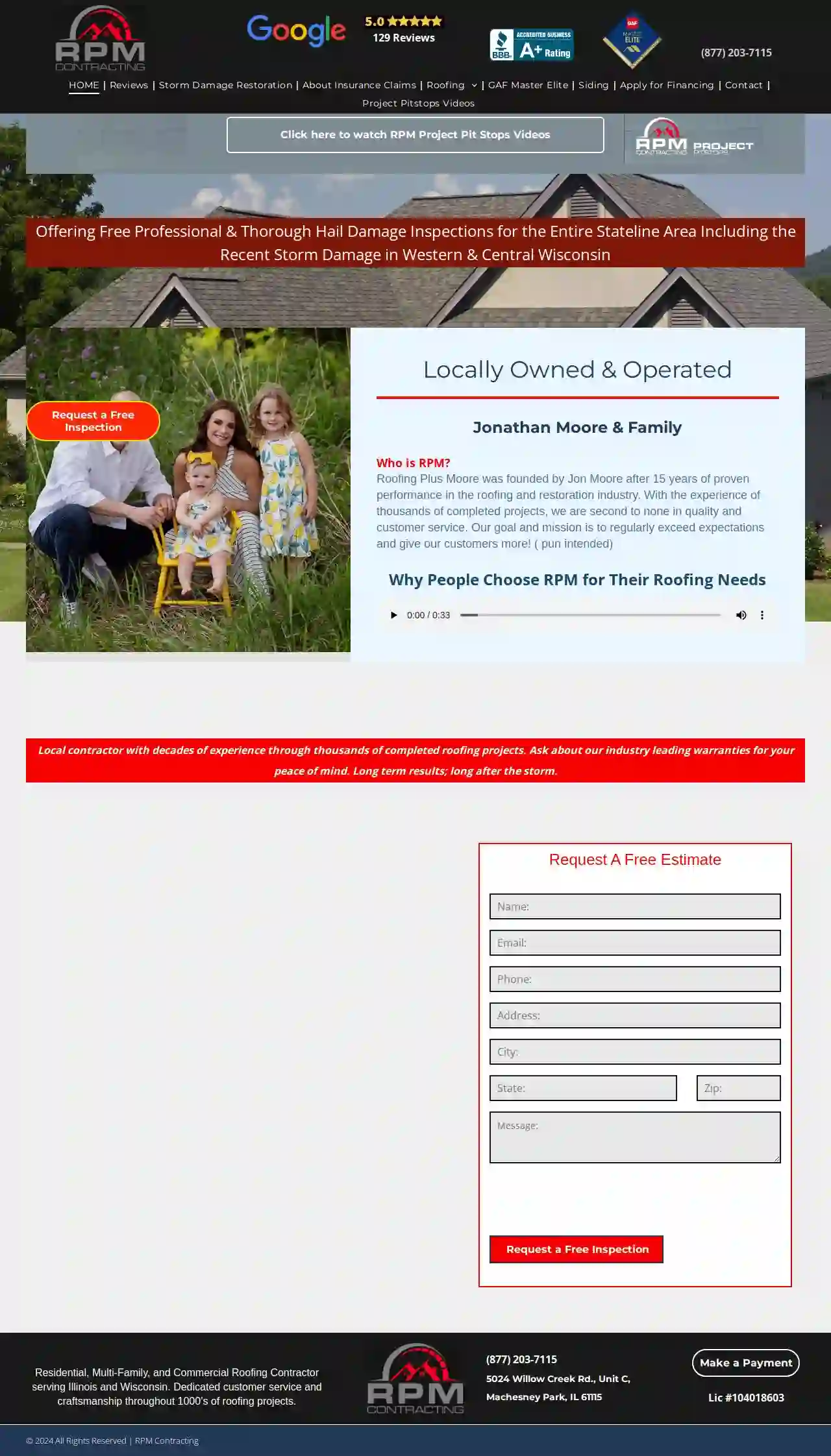
RPM Contracting LLC
5127 reviews5024 Willow Creek Rd., Unit C, Machesney Park, 61115, USRPM Roofing Plus Moore is a locally owned and operated roofing and restoration company serving Illinois and Wisconsin. With over 15 years of experience, we have completed thousands of projects and have a proven track record of quality and customer service. Our goal is to exceed expectations and give our customers more. We offer free professional and thorough hail damage inspections, and our team will work with you and your insurance company to improve the value of your home. We maintain the highest standards and are known for our service after the sale. We are not a company that pressures you into signing up by confusing you or making unrealistic claims. We will ethically and professionally work with you to earn your business.
- Services
- Why Us?
- Our Team
- Testimonials
- Gallery
Get Quote
Over 17,196+ Roofers on our directory
Our roofing contractors operate in Broadview and surroundings!
Roofyng.com has curated and vetted the Best Roofing Businesses arround Broadview. Find a trustworthy pro today.
Frequently Asked Questions About Roofing Companies
- Experience: Companies with a solid track record and years of experience in the industry.
- Licensing and Insurance: Verify they are properly licensed to operate in your area and carry adequate insurance to protect you from liability.
- Certifications: Look for certifications from reputable organizations, demonstrating expertise in specific roofing materials or techniques.
- Positive Reviews: Check online reviews and testimonials from previous customers.
- Professionalism: Choose a company that communicates clearly, provides detailed estimates, and has a courteous and responsive team.
- Style: Consider your home's architectural style and choose a roofing material that complements it.
- Climate: Factor in your local climate conditions. Some materials perform better in extreme heat, cold, or high winds than others.
- Budget: Roofing materials have a wide range of costs. Determine your budget and choose materials that fit your financial constraints.
- Durability and Lifespan: Assess the expected lifespan and durability of different materials.
- Energy Efficiency: Choose materials with good insulation and reflectivity properties to improve your home's energy efficiency.
- Regular Inspections: Inspect your roof at least twice a year for signs of damage or wear and tear.
- Gutter Cleaning: Clean gutters and downspouts regularly to prevent clogs and ensure proper drainage.
- Tree Trimming: Trim overhanging branches to avoid damage from falling debris and reduce shade, preventing moss growth.
- Proper Ventilation: Ensure good attic ventilation to regulate temperature and moisture.
- Timely Repairs: Address any damage promptly to prevent escalation.
How do I find a good roofing company?
How do I choose the right roofing materials for my home?
What is the difference between a roof overlay and a roof tear-off?
Roof Overlay: Installing a new layer of roofing material over the existing roof. It's less expensive and faster, but not always ideal.
Roof Tear-Off: Completely removing the existing roofing before installing a new one. More labor-intensive but allows for inspection and repairs to the roof deck.
A tear-off is typically preferred, but a roofing contractor can advise on the best approach for your situation.
How do I prevent roof damage?
How do I find a good roofing company?
- Experience: Companies with a solid track record and years of experience in the industry.
- Licensing and Insurance: Verify they are properly licensed to operate in your area and carry adequate insurance to protect you from liability.
- Certifications: Look for certifications from reputable organizations, demonstrating expertise in specific roofing materials or techniques.
- Positive Reviews: Check online reviews and testimonials from previous customers.
- Professionalism: Choose a company that communicates clearly, provides detailed estimates, and has a courteous and responsive team.
How do I choose the right roofing materials for my home?
- Style: Consider your home's architectural style and choose a roofing material that complements it.
- Climate: Factor in your local climate conditions. Some materials perform better in extreme heat, cold, or high winds than others.
- Budget: Roofing materials have a wide range of costs. Determine your budget and choose materials that fit your financial constraints.
- Durability and Lifespan: Assess the expected lifespan and durability of different materials.
- Energy Efficiency: Choose materials with good insulation and reflectivity properties to improve your home's energy efficiency.
What is the difference between a roof overlay and a roof tear-off?
Roof Overlay: Installing a new layer of roofing material over the existing roof. It's less expensive and faster, but not always ideal.
Roof Tear-Off: Completely removing the existing roofing before installing a new one. More labor-intensive but allows for inspection and repairs to the roof deck.
A tear-off is typically preferred, but a roofing contractor can advise on the best approach for your situation.
How do I prevent roof damage?
- Regular Inspections: Inspect your roof at least twice a year for signs of damage or wear and tear.
- Gutter Cleaning: Clean gutters and downspouts regularly to prevent clogs and ensure proper drainage.
- Tree Trimming: Trim overhanging branches to avoid damage from falling debris and reduce shade, preventing moss growth.
- Proper Ventilation: Ensure good attic ventilation to regulate temperature and moisture.
- Timely Repairs: Address any damage promptly to prevent escalation.